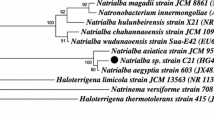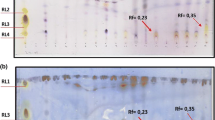Abstract
A newly marine Halomonas pacifica strain Cnaph3 was isolated, as a naphthalene degrader and biosurfactant producer, from contaminated seawater collected in Ataya’s fishing harbor, located in Kerkennah Islands, Tunisia. Chromatography flame ionization detector analysis revealed that 98.8% of naphthalene (200 mg/L) was degraded after 7 days of incubation, at 30 g/L NaCl and 37 °C. Strain Cnaph3 showed also a noticeable capacity to grow on a wide range of aliphatic, aromatic, and complex hydrocarbons. Interestingly, strain Cnaph3 showed a significant potential to produce biosurfactants in the presence of all tested substrates, particularly on glycerol (1%, v/v). Electrospray ionization analysis of the biosurfactant, designated Bios-Cnaph3, suggested a lipopeptide composition. The critical micelle concentration of Bios-Cnaph3 was about 500 mg/L. At this concentration, the surface tension of the water was reduced to 27.6 mN/m. Furthermore, Bios-Cnaph3 displayed interesting stabilities over a wide range of temperatures (4–105 °C), salinities (0–100 g/L NaCl), and pH (2.2–12.5). In addition, it showed promising capacities to remove used motor oil from contaminated soils. The biodegradation and biosurfactant-production potential of the Halomonas sp. strain Cnaph3 would present this strain as a favorite agent for bioremediation of hydrocarbon-contaminated sites under saline conditions.





Similar content being viewed by others
References
Abdelkafi S, Labat M, Casalot L et al (2006) Isolation and characterization of Halomonas sp. strain IMPC, a p-coumaric acid-metabolizing bacterium that decarboxylates other cinnamic acids under hypersaline conditions. FEMS Microbiol Lett 255:108–114. https://doi.org/10.1111/j.1574-6968.2005.00061.x
Alva VA, Peyton BM (2003) Phenol and catechol biodegradation by the Haloalkaliphile Halomonas campisalis: influence of pH and salinity. Environ Sci Technol 37:4397–4402. https://doi.org/10.1021/es0341844
Alvonita M, Hertadi R (2018) Bioconversion of glycerol to biosurfactant by halophilic bacteria Halomonas elongata BK-AG18. Indones J Chem. https://doi.org/10.22146/ijc.26737
Al-Wahaibi Y, Joshi S, Al-Bahry S et al (2014) Biosurfactant production by Bacillus subtilis B30 and its application in enhancing oil recovery. Colloids Surf B 114:324–333. https://doi.org/10.1016/j.colsurfb.2013.09.022
Arulazhagan P, Vasudevan N (2011) Biodegradation of polycyclic aromatic hydrocarbons by a halotolerant bacterial strain Ochrobactrum sp. VA1. Mar Pollut Bull 62:388–394. https://doi.org/10.1016/j.marpolbul.2010.09.020
Azubuike CC, Chikere CB, Okpokwasili GC (2016) Bioremediation techniques-classification based on site of application: principles, advantages, limitations and prospects. World J Microbiol Biotechnol 32:180. https://doi.org/10.1007/s11274-016-2137-x
Banat IM, Satpute SK, Cameotra SS et al (2014) Cost effective technologies and renewable substrates for biosurfactants production. Front Microbiol. https://doi.org/10.3389/fmicb.2014.00697
Baumann L, Bowditch RD, Baumann P (1983) Description of Deleya gen. nov. created to accommodate the marine species Alcaligenes aestus, A. pacijicus, A. cupidus, A. venustus, and Pseudomonas marina. Int J Syst Bacteriol 33:793–802
Cao X-H, Liao Z-Y, Wang C-L et al (2009) Evaluation of a lipopeptide biosurfactant from Bacillus natto TK-1 as a potential source of anti-adhesive, antimicrobial and antitumor activities. Braz J Microbiol 40:373–379. https://doi.org/10.1590/S1517-838220090002000030
Cerniglia CE (1992) Biodegradation of polycyclic aromatic hydrocarbons. In: Rosenberg E (ed) Microorganisms to combat pollution. Springer, Netherlands, Dordrecht, pp 227–244
Chamkha M, Trabelsi Y, Mnif S, Sayadi S (2011) Isolation and characterization of Klebsiella oxytoca strain degrading crude oil from a Tunisian off-shore oil field. J Basic Microbiol 51:580–589. https://doi.org/10.1002/jobm.201100073
Chebbi A, Jaoua H, Loukil S et al (2016) Biodegradation of malodorous mercaptans by a novel Staphylococcus capitis strain isolated from gas-washing wastewaters of the Tunisian Chemical Group. Int J Environ Sci Technol 13:571–580. https://doi.org/10.1007/s13762-015-0897-8
Chebbi A, Hentati D, Zaghden H et al (2017) Polycyclic aromatic hydrocarbon degradation and biosurfactant production by a newly isolated Pseudomonas sp. strain from used motor oil-contaminated soil. Int Biodeterior Biodegrad 122:128–140. https://doi.org/10.1016/j.ibiod.2017.05.006
Coronel-León J, de Grau G, Grau-Campistany A et al (2015) Biosurfactant production by AL 1.1, a Bacillus licheniformis strain isolated from Antarctica: production, chemical characterization and properties. Ann Microbiol 65:2065–2078. https://doi.org/10.1007/s13213-015-1045-x
da Silva GP, Mack M, Contiero J (2009) Glycerol: a promising and abundant carbon source for industrial microbiology. Biotechnol Adv 27:30–39. https://doi.org/10.1016/j.biotechadv.2008.07.006
Dave D, Ghaly AE (2011) Remediation technologies for marine oil spills: a critical review and comparative analysis. J Environ Sci 7(5):423
de França ÍWL, Lima AP, Lemos JAM et al (2015) Production of a biosurfactant by Bacillus subtilis ICA56 aiming bioremediation of impacted soils. Catal Today 255:10–15. https://doi.org/10.1016/j.cattod.2015.01.046
Dhasayan A, Kiran GS, Selvin J (2014) Production and characterisation of glycolipid biosurfactant by Halomonas sp. MB-30 for potential application in enhanced oil recovery. Appl Biochem Biotechnol 174:2571–2584. https://doi.org/10.1007/s12010-014-1209-3
Donio MBS, Ronica FA, Viji VT et al (2013) Halomonas sp. BS4, a biosurfactant producing halophilic bacterium isolated from solar salt works in India and their biomedical importance. SpringerPlus. https://doi.org/10.1186/2193-1801-2-149
Faragallah HM, Askar AI, Okbah MA, Moustafa HM (2009) Physico-chemical characteristics of the open Mediterranean sea water far about 60 Km from Damietta harbor. Egypt J Ecol Nat Enivorn 1(5):106–119
Fathepure BZ (2014) Recent studies in microbial degradation of petroleum hydrocarbons in hypersaline environments. Front Microbiol. https://doi.org/10.3389/fmicb.2014.00173
Garcia MT, Mellado E, Ostos JC, Ventosa A (2004) Halomonas organivorans sp. nov., a moderate halophile able to degrade aromatic compounds. Int J Syst Evol Microbiol 54:1723–1728. https://doi.org/10.1099/ijs.0.63114-0
Gifford SP, Macfarlane GR, O’Connor WA, Dunstan RH (2006) Effect of the pollutants lead, zinc, hexadecane and octocosane on total growth and shell growth in the akoya pearl oyster, pinctada imbricata. J Shellfish Res 25:159–165. https://doi.org/10.2983/0730-8000(2006)25[159:EOTPLZ]2.0.CO;2
Global Climate Report (2015) Global Climate Report—Annual 2015 | State of the Climate | National Centers for Environmental Information (NCEI). https://www.ncdc.noaa.gov/sotc/global/201513. Accessed 15 May 2019
Güven KC, Yazici Z, Ünlü S et al (1997) Oil pollution on sea water and sediments of Istanbul Strait caused by Nassia Tanker accident. Turk J Marit Mar Sci 2:65–85
Hentati D, Chebbi A, Loukil S et al (2016) Biodegradation of fluoranthene by a newly isolated strain of Bacillus stratosphericus from Mediterranean seawater of the Sfax fishing harbour, Tunisia. Environ Sci Pollut Res 23:15088–15100. https://doi.org/10.1007/s11356-016-6648-7
Hentati D, Chebbi A, Hadrich F et al (2019) Production, characterization and biotechnological potential of lipopeptide biosurfactants from a novel marine Bacillus stratosphericus strain FLU5. Ecotoxicol Environ Saf 167:441–449. https://doi.org/10.1016/j.ecoenv.2018.10.036
Huber C, Klimant I, Krause C et al (2000) Optical sensor for seawater salinity. Fresenius J Anal Chem 368:196–202. https://doi.org/10.1007/s002160000493
Khopade A, Biao R, Liu X et al (2012) Production and stability studies of the biosurfactant isolated from marine Nocardiopsis sp. B4. Desalination 285:198–204. https://doi.org/10.1016/j.desal.2011.10.002
Klein B, Roether W, Manca BB et al (1999) The large deep water transient in the Eastern Mediterranean. Deep Sea Res I 46:371–414. https://doi.org/10.1016/S0967-0637(98)00075-2
Lin C, Gan L, Chen Z-L (2010) Biodegradation of naphthalene by strain Bacillus fusiformis (BFN). J Hazard Mater 182:771–777. https://doi.org/10.1016/j.jhazmat.2010.06.101
Lotfabad TB, Shourian M, Roostaazad R et al (2009) An efficient biosurfactant-producing bacterium Pseudomonas aeruginosa MR01, isolated from oil excavation areas in south of Iran. Colloids Surf B 69:183–193. https://doi.org/10.1016/j.colsurfb.2008.11.018
Mnif S, Chamkha M, Sayadi S (2009) Isolation and characterization of Halomonas sp. strain C2SS100, a hydrocarbon-degrading bacterium under hypersaline conditions. J Appl Microbiol 107:785–794. https://doi.org/10.1111/j.1365-2672.2009.04251.x
Morley NH, Burton JD, Tankere SPC, Martin J-M (1997) Distribution and behaviour of some dissolved trace metals in the western Mediterranean Sea. Deep Sea Res II 44:675–691. https://doi.org/10.1016/S0967-0645(96)00098-7
Ndlovu T, Rautenbach M, Khan S, Khan W (2017) Variants of lipopeptides and glycolipids produced by Bacillus amyloliquefaciens and Pseudomonas aeruginosa cultured in different carbon substrates. AMB Express. https://doi.org/10.1186/s13568-017-0367-4
Ojha N, Mandal SK, Das N (2019) Enhanced degradation of indeno (1,2,3-cd) pyrene using Candida tropicalis NN4 in presence of iron nanoparticles and produced biosurfactant: a statistical approach. 3 Biotech 9:86. https://doi.org/10.1007/s13205-019-1623-x
Pecci Y, Rivardo F, Martinotti MG, Allegrone G (2010) LC/ESI-MS/MS characterisation of lipopeptide biosurfactants produced by the Bacillus licheniformis V9T14 strain. J Mass Spectrom 45:772–778. https://doi.org/10.1002/jms.1767
Peele KA, Ravi Teja Ch V, Kodali VP (2016) Emulsifying activity of a biosurfactant produced by a marine bacterium. 3 Biotech 6:177. https://doi.org/10.1007/s13205-016-0494-7
Quesada E, Valderrama MJ, Bejar V et al (1990) Volcaniella eurihalina nov sp. nov. a moderately halophilic nonmotile gram-negative rod. Int J Syst Bacteriol 40:261–267
Rahman KSM, Rahman TJ, McClean S et al (2002) Rhamnolipid biosurfactant production by strains of Pseudomonas aeruginosa using low-cost raw materials. Biotechnol Prog 18:1277–1281. https://doi.org/10.1021/bp020071x
Santos D, Rufino R, Luna J et al (2016) Biosurfactants: multifunctional biomolecules of the 21st century. Int J Mol Sci 17:401. https://doi.org/10.3390/ijms17030401
Sari IP, Basyiruddin MI, Hertadi R (2018) Bioconversion of palm oil into biosurfactant by Halomonas meridiana BK-AB4 for the application of corrosion inhibitor. Indones J Chem 18:718. https://doi.org/10.22146/ijc.27040
Sharma R, Singh J, Verma N (2018) Optimization of rhamnolipid production from Pseudomonas aeruginosa PBS towards application for microbial enhanced oil recovery. 3 Biotech 8:20. https://doi.org/10.1007/s13205-017-1022-0
Singh P, Patil Y, Rale V (2019) Biosurfactant production: emerging trends and promising strategies. J Appl Microbiol 126:2–13. https://doi.org/10.1111/jam.14057
Tornero V, Hanke G (2016) Chemical contaminants entering the marine environment from sea-based sources: a review with a focus on European seas. Mar Pollut Bull 112:17–38. https://doi.org/10.1016/j.marpolbul.2016.06.091
US EPA (1986) Quality criteria for water. United States Environmental Protection Agency. Washington, D.C. EPA 440/5-86-001. Accessed 6 Apr 2019
US EPA (2011) Criteria revisions published in 2002 National Recommended Water Quality Criteria, EPA-822-R-02-047. Accessed 15 May 2019
Vreeland RH, Litchfield CD, Martin EL, Elliot E (1980) Halomonas elongata, a new genus and species of extremely salt-tolerant bacteria. Int J Syst Bacteriol 30:485–495. https://doi.org/10.1099/00207713-30-2-485
Wang Y, Wu Y-H, Wang C-S et al (2008) Halomonas salifodinae sp. nov., a halophilic bacterium isolated from a salt mine in China. Int J Syst Evol Microbiol 58:2855–2858. https://doi.org/10.1099/ijs.0.2008/000729-0
Widdel F, Pfennig N (1981) Studies on dissimilatory sulfate-reducing bacteria that decompose fatty acids. Arch Microbiol 129:395–400. https://doi.org/10.1007/bf00406470
Zaghden H, Serbaji MM, Saliot A, Sayadi S (2016) The Tunisian Mediterranean coastline: potential threats from urban discharges Sfax-Tunisian Mediterranean coasts. Desalination Water Treat 57:24765–24777. https://doi.org/10.1080/19443994.2016.1149107
Zhang J, Xue Q, Gao H et al (2016) Production of lipopeptide biosurfactants by Bacillus atrophaeus 5–2a and their potential use in microbial enhanced oil recovery. Microb Cell Factories. https://doi.org/10.1186/s12934-016-0574-8
Acknowledgements
This research was supported by a grant provided by the Tunisian Ministry of Higher Education and Scientific Research and the Laboratory of Environmental Bioprocesses, Centre of Biotechnology of Sfax, Tunisia. This work was also partially financed by the Ministerio de Economia y Competitividad, Spain. Authors would like to thank Mrs. Fatma Rezgui for her technical assistance in GC–MS analyses, Mr. Nidhal Baccar for his technical assistance in GC-FID and FTIR analyses and Mr. Slim Loukil for his help with chemical analyses. Finally, the authors would like to thank Dr. Ayadi Hajji for proofreading, correcting and improving the English of the manuscript.
Author information
Authors and Affiliations
Contributions
MC performed most of the experiments, data analysis and drafted the manuscript, DH helped in the manuscript interpretation, AC helped in the Phylogenetic analysis, NM performed the molecular analysis, Professor SS assisted with financial support, Professor AMM performed the ESI–MS analysis and Professor MC designed and directed the study.
Corresponding author
Ethics declarations
Conflict of interest
The authors declare that they have no conflict of interest regarding the publication of this manuscript.
Electronic supplementary material
Below is the link to the electronic supplementary material.
Rights and permissions
About this article
Cite this article
Cheffi, M., Hentati, D., Chebbi, A. et al. Isolation and characterization of a newly naphthalene-degrading Halomonas pacifica, strain Cnaph3: biodegradation and biosurfactant production studies. 3 Biotech 10, 89 (2020). https://doi.org/10.1007/s13205-020-2085-x
Received:
Accepted:
Published:
DOI: https://doi.org/10.1007/s13205-020-2085-x




